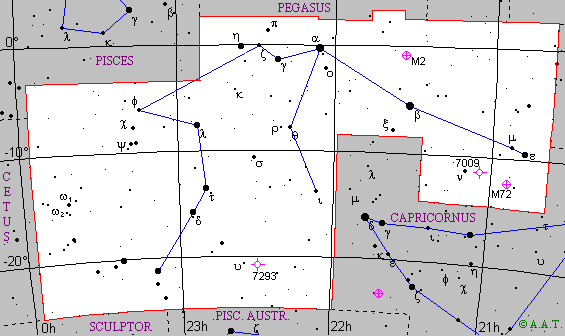 |
 |
| English name | Water Bearer | ||||
|---|---|---|---|---|---|
| Major stars | alpha Aquarii | Sadalmelik | magn. 3,2 | RA: 22h 05m 47.03s | Dec: -00° 19' 11.4" |
| beta Aquarii | Sadalsuud | magn. 3,1 | RA: 21h 31m 33.54s | Dec: -05° 34' 16.2" | |
| delta Aquarii | Skat | magn. 3,5 | RA: 22h 54m 39.02s | Dec: -15° 49' 14.9" | |
| Description | Constellation of the zodiac, through which the Sun transits from the middle of February to the middle of March. It is to the south of Pegasus, between Cetus and Capricornus.
|
||||
| Mythology and history | Greeks identified the Aquarius with Ganymede, the most beautiful boy ever lived on the face of the Earth: so much beautiful that the king of the gods himself, Zeus, fell in love with him and, changed into an eagle (remembered in the near constellation of Aquila), abducted him and took him on the Olympus. In the celestial palace Ganymede became the cupbearer of the gods, responsible of pouring out the divine nectar, the ambrosia. According to another version, this constellation was identified with Deucalion, the son of Prometheus escaped from the downpour: for this reason he is withdrawn in the action to upset a pitcher of water. Such version was brought by Julius Caesar Germanicus. |
||||
 Back to constellations page.
Back to constellations page.